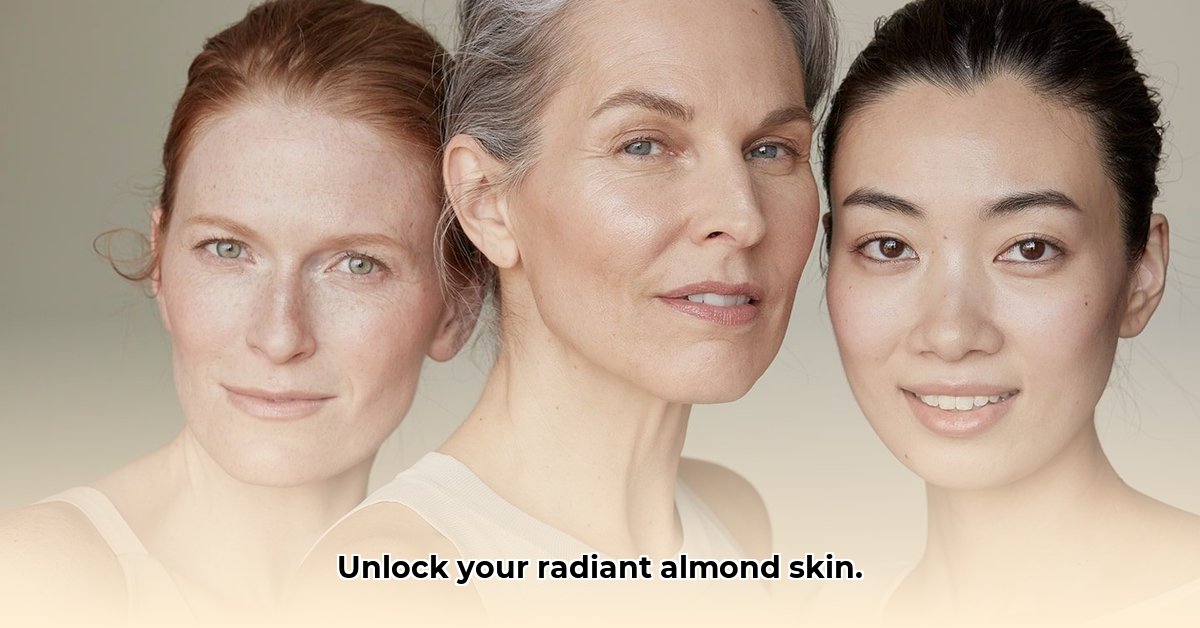Got almond skin and want that healthy glow? This guide is your secret weapon! We’ll break down everything you need to know about those gorgeous medium-brown tones, from figuring out whether you’re cool or warm-toned to building a skincare routine that’s perfect for you. We’ll tackle common issues like dark spots, show you how to pick the best makeup, and explain why sun protection is *so* important. For more in-depth information, check out this helpful guide on [almond skin tones](https://happilylive.com/almond-skin-tone/). Get ready to discover your most radiant self!
Unlocking the Secrets of Almond Skin Undertones
Almond skin—that gorgeous medium-brown complexion—is far more diverse than you might think! It’s not a one-size-fits-all situation. The key to truly radiant almond skin lies in understanding its subtle undertones. These are the hints of color—cool, warm, or neutral—that gently influence how your skin reacts to things like sunlight, makeup, and your skincare routine. Understanding your undertone is essential for selecting the most flattering makeup shades and clothing colors, as well as for choosing skincare ingredients that address your specific needs. Let’s explore this fascinating world of almond skin undertones!
Decoding Your Almond Skin Undertones: It’s Easier Than You Think!
Ever wondered why certain foundation shades look absolutely flawless on you, while others just seem…off? It’s all about those undertones! Almond skin can have cool undertones (think hints of pink, blue, or even a subtle red), warm undertones (with golden, yellow, or olive tones), or neutral undertones (a balance of both). Figuring out yours is surprisingly simple. Let’s try a few easy, at-home tests to identify your skin’s undertones:
- The Vein Check: Take a peek at the veins on your inner wrist in natural light. See mostly blue or purple? You likely have cool undertones. More green? You probably have warm undertones. A mix of blue-green? Congratulations, you’ve got neutral undertones!
- The Jewelry Test: Consider which metal complements your skin more. Gold jewelry typically flatters warm undertones, making the skin appear brighter and more radiant. Silver jewelry tends to highlight cool undertones, creating a similar effect. If both gold and silver look equally good, you likely have neutral undertones.
- The White Clothing Test: Hold a bright white garment up to your face, then try an off-white or cream color. Does the bright, crisp white make your skin shine, or does the warmer, creamier ivory look better? Jewel tones like emerald green or sapphire blue tend to flatter cool undertones, while earth tones like olive, rust, and mustard complement warm undertones.
- The Sun Test: How does your skin react to sun exposure? Do you tend to tan easily, or do you burn first? Those with warm undertones often tan more readily, while those with cool undertones may be more prone to sunburn.
Knowing your undertones is the first step toward creating a skincare and makeup routine that truly works for you. This knowledge enables you to choose products that enhance your natural beauty, address your specific concerns, and create a harmonious, radiant look. This also helps you to understand why certain colors of clothing look better than others.
Skincare Secrets for Almond Skin: A Personalized Approach
Almond skin is often prone to hyperpigmentation (those pesky dark spots and patches) and can sometimes experience sensitivity or dehydration, so a consistent, gentle skincare routine is essential. Regardless of whether you have cool, warm, or neutral undertones, one thing remains vital: sun protection! Always use a broad-spectrum sunscreen with an SPF of 30 or higher—every day, rain or shine. Reapply every two hours when exposed to direct sunlight. Look for formulas that are non-comedogenic (won’t clog pores) and suitable for sensitive skin. Trust me, your skin will thank you!
For Cool Undertones: Look for products with brightening and soothing ingredients. Alpha arbutin and niacinamide (a form of vitamin B3) are excellent to help brighten your complexion and even out your skin tone, combating any dullness. Ingredients like aloe vera, chamomile, and green tea extract can also help to calm and soothe the skin, reducing redness and irritation.
For Warm Undertones: Focus on hydration, gentle exfoliation, and antioxidant protection. Products containing hyaluronic acid (a humectant that draws moisture to the skin), vitamin E, and ferulic acid are your new best friends. Gentle exfoliating acids like lactic acid or mandelic acid can help to remove dead skin cells and promote a brighter, more even skin tone.
For Neutral Undertones: You can often use a wider range of products, focusing on overall skin health and addressing any specific concerns you may have, such as acne or dryness.
Remember, the magic word here is consistency. Aim for a simple routine: cleanse (with a gentle, sulfate-free cleanser), tone (optional, with an alcohol-free toner), treat (with serums or targeted treatments), moisturize, and protect. That’s it! Keep it consistent, and you’ll see a real difference.
Makeup Magic: Finding Your Perfect Shade Match
Choosing the right foundation, concealer, and other makeup shades is crucial for achieving a natural, flawless look. Matching your foundation to your undertones is key. Here’s a helpful guide for selecting makeup products for different almond skin undertones:
| Undertones | Foundation Shade Suggestions | Concealer Shade Suggestions | Blush Shade Suggestions | Eyeshadow Shade Suggestions | Lipstick Shade Suggestions |
|---|---|---|---|---|---|
| Cool | Rose, pink, or blue-based shades; look for words like “ivory,” “porcelain,” or “cool beige” | Pink or peach-toned concealers; avoid yellow-based concealers that can look ashy | Pink, rose, mauve | Silvers, pinks, purples, smoky grays | Berry shades, cool reds, pink nudes |
| Warm | Golden, yellow, or peach-based shades; look for words like “golden,” “honey,” or “warm beige” | Yellow or golden-toned concealers; avoid pink-based concealers that can look too bright | Peach, coral, bronze | Golds, bronzes, browns, warm greens | Warm reds, corals, peach nudes |
| Neutral | Experiment with blends of cool and warm tones; look for words like “natural,” “buff,” or “beige” | Experiment with both pink and yellow-toned concealers to find the best match | Versatile shades that suit outfit | Neutrals, browns, taupes; experiment with a variety of colors | Nude shades, rosy pinks, berry tones; experiment to find your favorites |
Don’t be afraid to experiment! Visit a makeup counter and ask for assistance in finding shades that complement your skin tone and undertones. Consider getting professionally matched to find the right foundation. Look for retailers that offer generous return policies, so that you can test a product for several days and return if unsatisfied. Remember that lighting in retail stores can vary. It’s best to test makeup in natural light to ensure the right shade selection.
Tackling Hyperpigmentation: Prevention and Treatment
Hyperpigmentation is unfortunately more common in almond skin due to the higher concentration of melanin. However, with consistent effort, it can be managed and minimized.
- Sun Protection (Again!): This cannot be stressed enough. It’s the single most important thing you can do to prevent and reduce hyperpigmentation.
- Gentle Exfoliation: Chemical exfoliants like lactic acid, mandelic acid, azelaic acid, and glycolic acid (AHAs) can gently help fade dark spots and promote cell turnover. Start slowly and be patient; results take time. Over-exfoliating can irritate the skin and worsen hyperpigmentation, so be careful not to overdo it.
- Targeted Treatments: Over-the-counter serums and creams containing ingredients like hydroquinone, kojic acid, alpha arbutin, and vitamin C can lighten hyperpigmentation. However, it’s always best to consult a dermatologist before using these, as some (like hydroquinone) can be potent and may cause irritation or other side effects.
- Professional Treatments: For more stubborn hyperpigmentation, consider professional treatments like laser therapy (e.g., Fraxel, PicoSure), microdermabrasion, or chemical peels. Always consult a dermatologist first. These treatments are more powerful and require expert guidance to minimize the risk of side effects.
Lifestyle changes like managing stress, getting enough sleep, and eating a healthy diet can also contribute to overall skin health and may help to reduce hyperpigmentation.
Remember, patience is a virtue when it comes to treating hyperpigmentation. Results may take weeks or even months.
Celebrate Your Unique Beauty!
Almond skin is truly stunning, and understanding its complexities—especially those subtle undertones—empowers you to care for your skin effectively and enhance its natural radiance. Take your time, experiment with different products and techniques, and trust the journey. Embrace your unique beauty—you are radiant!
Best Treatments for Hyperpigmentation on Almond Skin
Key Takeaways:
- Almond skin, often with warm undertones, is prone to hyperpigmentation.
- Sun protection is paramount – always use an SPF 30
- Plant-based Diet Colitis Remission: Success Stories - December 18, 2025
- Plant Based Diet Breast Cancer: Research-Based Benefits - December 16, 2025
- Plant-Based Diet Ulcerative Colitis Remission: Proven Benefits - December 15, 2025










